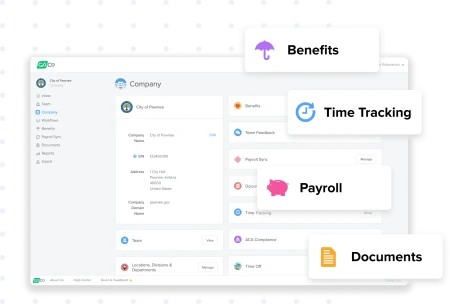Exempt vs Non-Exempt Employees: Everything HR Needs to Know
One of the most important things HR has to keep track of for compliance is which employees are exempt vs. non-exempt.
December 16th, 2022
One of the most important things HR has to keep track of for compliance is which employees are exempt vs. non-exempt. This article will go over the main differences between these categories, how to determine if an employee is exempt or non-exempt under federal law, how that will impact a company’s employees, and how to determine an employee’s classification.
Exempt vs. Non-Exempt: What's the Difference?
The proper classification of an employee as exempt or non-exempt is essential in order to avoid legal ramifications tied to the FLSA.
The FLSA, which stands for Fair Labor Standards Act, is a government act that establishes standards regarding overtime pay, minimum wage, recordkeeping, and youth employment. The original Fair Labor Standards Act was signed in June of 1938 but has been updated since, such as when an updated federal minimum wage of $7.25 per hour went into effect in July of 2009.
One of the many things the FLSA governs is which employees are exempt and which are non-exempt. Check out our compliance guide to learn about FLSA and other HR compliance issues.
Download the 2023 HR Compliance Calendar
What is an Exempt Employee?
Exempt employees are non-hourly employees who receive a regular, predetermined salary at certain intervals. Usually, this means that they are exempt from minimum wage and overtime pay, meaning they are not entitled to either, however in order to qualify for an exempt status, they must earn a minimum of $684 per week. Salaried employees may receive their pay weekly, biweekly, bimonthly, or even monthly; the time intervals between salary payments do not have an impact on whether or not an employee is considered exempt.
What is a Non-Exempt Employee?
Non-exempt employees are usually hourly employees and are eligible for both minimum wage and overtime pay. Overtime pay for non-exempt employees is calculated at 1.5 times their regular hourly pay for any hours worked over the standard hours for their job (usually 40) in a given week. Overtime pay is subject to both federal and state standards, so it’s important to make sure that all non-exempt employees are compensated accordingly.
According to the Fair Labor Standards Act, hourly employees are classified as "an employee who is employed on a salary, wage, commission or piecework basis and paid at least once per month." Hourly employees receive their earnings according to the number of hours they work. Hourly employees in the United States need to be classified as such according to the Fair Labor Standards Act. Those who fall under this category are those who earn only on a salary, wage, commission, or piecework basis and are paid at least once per month.
Salaried employees are usually employed full-time and receive a fixed salary each pay period. Although salaried employees are usually exempt, they can be considered non-exempt employees if their salary is for a fixed number of hours per week, and they are eligible for overtime pay if they exceed that number.
How to Determine if an Employee is Exempt or Non-Exempt
To determine if an employee is exempt or non-exempt, it’s important to review the requirements from the Department of Labor for different types of exemptions. As of this writing, there are 5 different types of exemptions: executive, administrative, professional (which has two subcategories), computer employee, and outside sales. It’s critical that HR departments are sure that they are applying the appropriate exemption requirements to people in the relevant roles.
Executive Exemption
For this type of exemption, the employee must:
Be compensated with a salary that is at least $684 per week;
Have a primary duty to manage the enterprise, a department of the enterprise, or a subdivision of the enterprise;
Consistently direct the work of at least two other full-time employees or an equivalent number of part-time employees; and
Have the authority to hire and fire employees or be able to make significant suggestions and recommendations as to hiring, firing, promotions, and other status changes of employees.
Administrative Exemption
For this type of exemption, the administrative employee must:
Be compensated with a salary that is at least $684 per week;
Have a primary duty that includes the use of independent judgment and discretion on significant matters; and
Have a primary responsibility of performing office or other non-manual work related to management or general business operations.
Professional Exemption
This type of exemption has two subcategories: learned professional and creative professional. Each one has different requirements.
To be considered an exempt learned professional employee, the employee must:
Be compensated with a salary or fee of at least $684 per week;
Perform work requiring advanced knowledge as their primary duty;
Have that advanced knowledge in a field of science or learning;
Have advanced knowledge that was acquired by extended study with specialized intellectual instruction.
To be considered an exempt creative professional employee, the employee must:
Be compensated with a salary or fee of at least $684 per week;
Have their primary duty be the performance of work that requires imagination, originality, invention, and/or talent in a recognized artistic or creative field.
Computer Employee Exemption
In order to qualify for this type of exemption, the employee must:
Be compensated either with a salary or fee of at least $684 per week or an hourly rate of at least $27.63 per hour;
Be employed as a computer programmer, computer systems analyst, software engineer, or equivalent skilled worker in the computer field.
Perform a primary duty of applying systems analysis techniques and procedures; designing, developing, documenting, analyzing, creating, testing, or modifying computer systems or programs; designing, documenting, testing, creating, or modifying computer programs related to machine operating systems; or a combination of the previously described duties that requires the same high level of skills.
Outside Sales Exemption
In order to qualify for this type of exemption, the employee must:
Have a primary duty of making sales or obtaining orders or contracts for services or for the use of facilities for which a consideration will be paid by the client or customer; and
Be regularly engaged away from the employer’s places of business.
Classifying Types of Employees as Exempt or Non-Exempt
Full-Time & Part-Time Employees: Either
A full-time employee in the United States is someone who works between 30 and 40 hours a week or 130 hours a month. A part-time employee in the United States is someone who works fewer than 30 hours a week. A part-time employee can be hourly or salaried. This type of employee is usually not entitled to any benefits and may not receive any type of paid time off. However, employers are responsible for paying taxes for both types of employees.
Technically, both full-time and part-time employees can be either exempt or non-exempt; it depends on how they are paid – if they are paid hourly, they are likely non-exempt, and if they are salaried and paid more than $684 per week, they are likely exempt.
Temporary & Seasonal Workers: Usually Non-Exempt
A person is classified as temporary or seasonal by HR if they work for the company for 3 months or less in a year. Temporary or seasonal employees are a cost-effective way for companies to fill gaps in their workforce. If an employer hires a temporary or seasonal worker directly instead of through an agency, the employer is responsible for tax withholdings. Seasonal workers are entitled to unemployment and Social Security benefits. Since temporary and seasonal workers are usually paid hourly wages, they are typically non-exempt – but make sure you check their employment requirements carefully against the FLSA guidelines.
Contractors & Other Contingent Workers (e.g. Freelancers and Consultants): Neither
If you have contingent workers, such as independent contractors, the company is not required to provide them with benefits such as health or disability insurance. Contractors, consultants, freelancers, and similar classifications often differ in the type of work they perform or the way they perform it. Contractors are not considered employees and are not covered by the FLSA, so they are not classified as exempt or non-exempt.
An independent contractor is defined by the IRS (Internal Revenue Service) as someone who operates in a business that they own and offers services in an independent way rather than being associated with one company. However, there are many complications in classifying an individual independent contractor. We typically recommend that employers consult with their state and local laws to ensure compliance.
Contractors can be classified as either 1099 or W-2. These two classifications deal with two different tax methods. 1099 contractors are usually self-employed and considered independent workers while W-2 contractors are employees of the hiring company and subject to social security contributions.
Interns: It Depends
An intern is an employee of a company who has not yet been classified as a regular employee and has no benefits. Interns are people who want to get a taste of what working in a company is like. It's a short-term work opportunity that gives interns the chance to learn, grow, and explore their interests outside of the classroom.
Internships are often unpaid but they can be great for gaining experience and knowledge about a particular career field. Many internships require students to enroll in classes at local colleges or universities, which makes them appealing to students who need credits, not jobs.
To be classified as an intern in the US, one must work fewer than 8 hours per day and have no authority to make a final decision on behalf of the company. There are stipulations around what an intern’s duties can be, particularly unpaid ones, so employers should consult with local and state guidance.
An intern's classification depends on their pay. Unpaid interns are not considered employees under the FLSA and are neither exempt nor non-exempt. If an intern is paid an hourly wage, it would make them a non-exempt employee.
Managing Compliance With GoCo
Exempt vs. non-exempt employee classification is just one of the many aspects of compliance you’re responsible for as an HR leader. If you’re ready to work smarter with powerful HR software, take a tour of GoCo and learn how we can help you manage compliance and more in a flexible, streamlined way.
FAQs
-
The main differences between exempt and non-exempt employees are:
Exempt employees are paid a predetermined salary distributed at regular intervals; non-exempt employees are usually paid hourly for their specific amount of time worked.
Exempt employees do not qualify for minimum wage; non-exempt employees do qualify for minimum wage.
Exempt employees do not receive overtime pay; non-exempt employees must receive overtime pay.
-
Worker classification impacts employee wages and scheduling based on which employees are able to receive overtime pay. While an hour or two of overtime every now and then may not be of much significance, it can add up over time or across several employees, so it’s important to consider which employees are eligible for overtime wages when scheduling out each week.
-
In general, salary workers are exempt, and hourly workers are non-exempt. There are notable exceptions to this general guidance, so be sure to review the FLSA requirements for employees to be considered exempt each time an employee’s classification is determined as exempt or non-exempt.
Updated 8/25/2023

Subscribe to Beyond The Desk to get insights, important dates, and a healthy dose of HR fun straight to your inbox.
Subscribe hereRecommended Posts
52 Hilarious HR Memes For 2023
Blog Articles
Search...
Product
GoCo
Resources
Articles
eBooks
Webinars
Customer Stories


![Why is HR Compliance Important in 2024? [+Free Checklist]](/img/containers/assets/goco/featured_images/posts/the-importance-of-hr-compliance.png/b73096df7f78bcf9874200ba0eaccf0a.png)
![Complete 2024 HR Compliance Calendar and Important Deadlines [+Download]](/img/containers/assets/goco/featured_images/posts/2024compliancecalendar-2.png/fd610000def14287c5dae38bf0b4ed97.png)

